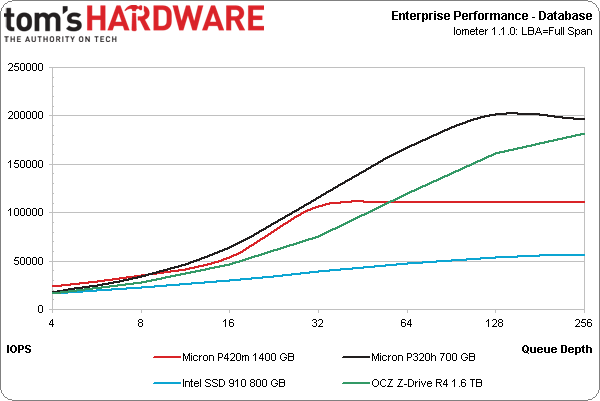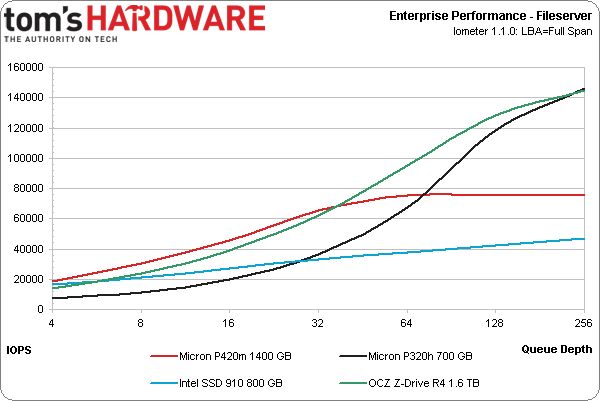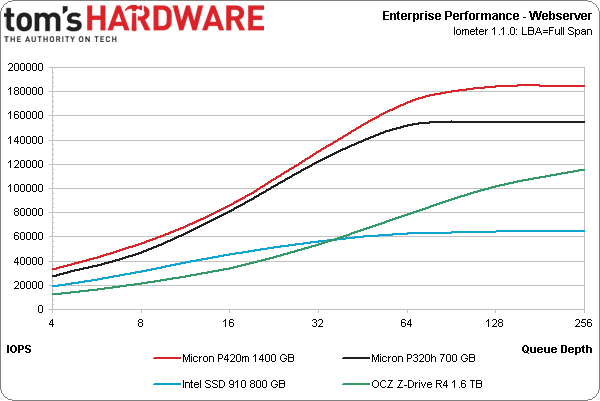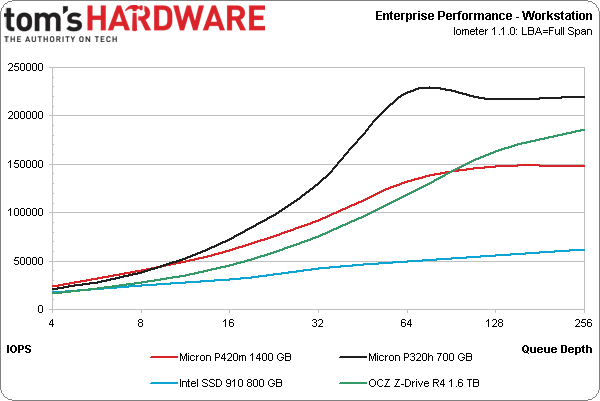Micron P420m SSD Review: 1.4 TB Of PCI Express-Attached Storage
After the success of its P320h, Micron is following up with the P420m, an MLC-based PCI Express x8 add-in card aimed at more read-oriented enterprise customers. How does it compare to the company's SLC-based flagship? We benchmark ours thoroughly.
Results: Enterprise Workload Performance
Our next set of tests simulates different enterprise-oriented workloads, including database, file server, Web server, and workstation configurations.
The database workload (also categorized as transaction processing) involves purely random I/O. Its profile consists of 67% reads and 33% writes using 8 KB transfers.
The P420m holds its own at lower queue depths, but can't keep up with Micron's flagship at higher queue depths. It does best Intel's SSD 910 though, eventually doubling its effort. The P420m owes a lot of its performance at lower queue depths to the flat random write performance across all queue depths.
In the file server workload, which consists of 80% random reads of varying transfer sizes, we see the same basic results. Micron's P420m once again runs out of steam against the P320h and the Z-Drive at higher queue depths, but nearly doubles the SSD 910.
Our Web server workload (100% read, varying transfer size), gives us a curious result. The P420m comes out on top across the board. We're going to chalk this up to our P320h not quite living up to its read specification on our test bench. In practice, both Micron drives should be about equal.
Finally, the workstation benchmark (80% reads, 80% random), shows the same general trend. Since the P320h and Z-Drive are not direct competitors, it's easy to write off any perceived shortcomings when comparing them to the P420h. The massive edge in read performance over Intel's SSD 910 shows up in our mixed workload tests, allowing the P420m to nearly double its performance.
Get Tom's Hardware's best news and in-depth reviews, straight to your inbox.
Current page: Results: Enterprise Workload Performance
Prev Page Results: Performance Consistency Next Page Results: Sequential Performance-
merikafyeah Seems like enterprise non-volatile storage is finally starting to approach the speeds of comsumer ram drives:Reply
http://www.thessdreview.com/our-reviews/romex-fancycache-review-ssd-performance-at-13gbs-and-765000-iops-in-60-seconds-flat/
Considering that the cost/GB of RAM is about $7/GB, it may not be such a bad idea to use RAM storage + backup generators instead of traditional non-volatile flash nand. -
rezzahd Maybe once the price drops I would pick one of these up, but I think we all know it will be a while before that happens.Reply -
BasslineJunkie Reply
Same here. I love the concept but price/gb isn't where it should be. But i do have some extra pci express slots that need filled!11507252 said:Maybe once the price drops I would pick one of these up, but I think we all know it will be a while before that happens.
-
utomo It is good to see good competition like now. keep comparing like this and hope soon we will get the good mature technology. now the SSD still have many improvement ideas. manufacturer need to work harder to win the market which is big.Reply -
ACTechy Awesome. Later down the road, when the price falls, these are going to be the thing to have. Really like PCI based SSD.Reply -
urbanman2004 TL;DR. I could benefit from something like this saving space on my system. It must have a hefty priceReply



